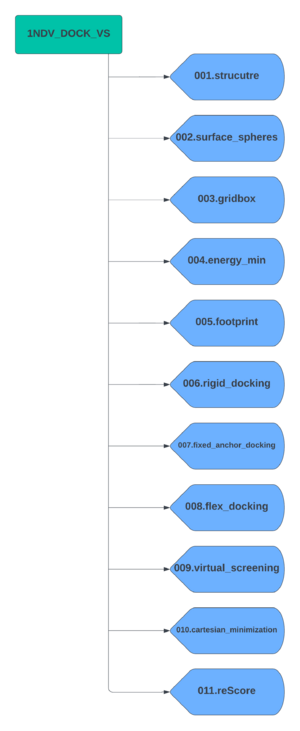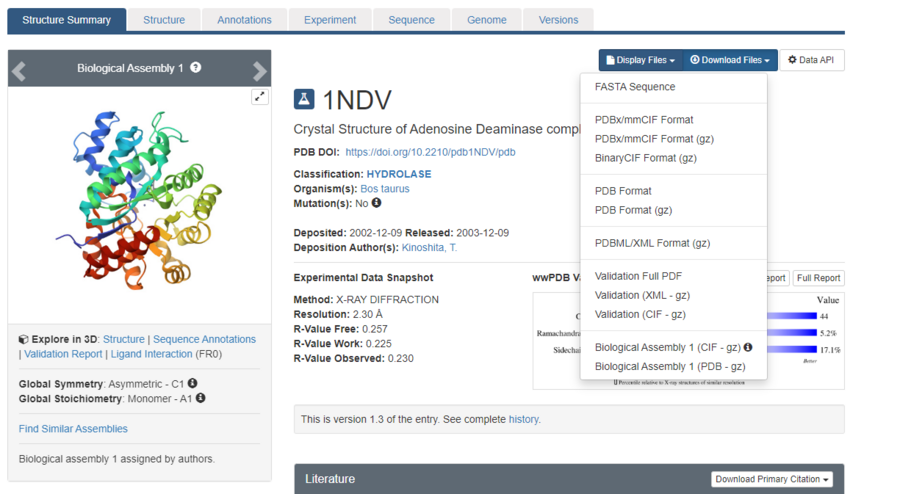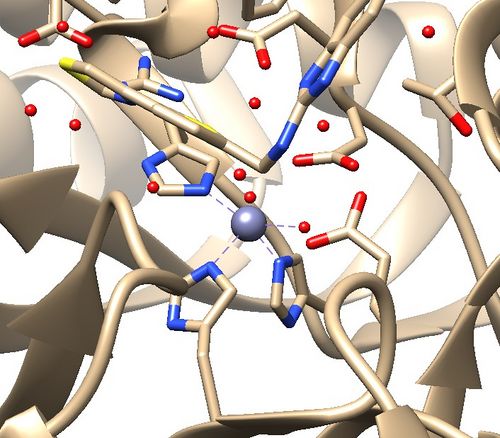Difference between revisions of "2024 DOCK tutorial 2 with PDBID 1NDV"
Stonybrook (talk | contribs) (→Downloading PDB 1NDV) |
Stonybrook (talk | contribs) (→Introduction) |
||
| Line 11: | Line 11: | ||
===== Creating Directories ===== | ===== Creating Directories ===== | ||
Create a parent directory which will contain all subdirectors for each docking step. For this tutorial we will name the parent directory 1NDV_DOCK_VS. Now create the subdirectories using the following scheme. | Create a parent directory which will contain all subdirectors for each docking step. For this tutorial we will name the parent directory 1NDV_DOCK_VS. Now create the subdirectories using the following scheme. | ||
| + | |||
[[File:1NDV_Chart.png|center|thumb]] | [[File:1NDV_Chart.png|center|thumb]] | ||
| + | |||
===== Downloading PDB File ===== | ===== Downloading PDB File ===== | ||
Visit the RCSB Protein Data Bank (PDB) [https://www.rcsb.org website] and use the search bar to search for your target protein. As stated before, we will be using 1NDV for this tutorial. | Visit the RCSB Protein Data Bank (PDB) [https://www.rcsb.org website] and use the search bar to search for your target protein. As stated before, we will be using 1NDV for this tutorial. | ||
| + | |||
[[File:PDB_SearchBar.png|center|thumb|upright=4.25]] | [[File:PDB_SearchBar.png|center|thumb|upright=4.25]] | ||
| + | |||
The page for the protein will look like this. Click the "Download Files" dropdown menu, and download the "PDB Format". | The page for the protein will look like this. Click the "Download Files" dropdown menu, and download the "PDB Format". | ||
| + | |||
[[File:1NDV-Download.png|thumb|center|upright=3]] | [[File:1NDV-Download.png|thumb|center|upright=3]] | ||
| + | |||
With the PDB file saved, we are now ready to begin generating files for DOCK! | With the PDB file saved, we are now ready to begin generating files for DOCK! | ||
Revision as of 15:35, 16 March 2024
Contents
Introduction
DOCK is a powerful computational tool used in drug design. "Docking" refers to the identification of low energy binding conformations of a small molecule, or ligand, in an active site. There are three methods in which DOCK performs docking: rigid, fixed anchor, and flexible. DOCK also has the ability to perform a virtual screen, which is analogous to a high throughput screen often performed in wet labs. This method allows for thousands of molecules to be docked and ranked so that the highest scoring molecules can move to the next stage of testing. A virtual screen can save both time and money when compared to a traditional high throughput screen. This tutorial will guide you through the process of performing each method of docking, a virtual screen, and associated analysis using PDB 1NDV. Replace 1NDV with your target protein in this tutorial.
Required Software and Skills
In order to complete this tutorial UCSF Chimera is required. Chimera is a powerful visualization tool that will aid in the preparation and analysis of the virtual screen. Please note that the newer version, Chimera X, can not be used for this tutorial as it lacks certain integrations with DOCK. While this tutorial will walk you through all steps necessary to use Chimera, it may be helpful to view this tutorial for a more in depth guide on the program.
It is also recommended that you have experience with Unix and vi. A Unix tutorial can be found on the site here and a vi tutorial can be found here.
Set-up
Before we begin, we need to set up our directories and download our file from the Protein Data Bank (PDB).
Creating Directories
Create a parent directory which will contain all subdirectors for each docking step. For this tutorial we will name the parent directory 1NDV_DOCK_VS. Now create the subdirectories using the following scheme.
Downloading PDB File
Visit the RCSB Protein Data Bank (PDB) website and use the search bar to search for your target protein. As stated before, we will be using 1NDV for this tutorial.
The page for the protein will look like this. Click the "Download Files" dropdown menu, and download the "PDB Format".
With the PDB file saved, we are now ready to begin generating files for DOCK!
Preparing Structure Files
Protein
Analyzing the Protein Structure:
Open your protein.pdb in Chimera.
Assess the protein structure:
1. Are there any missing loops?
2. Are there any metal coordination atoms forming key interactions with the protein?
The .pdb for 1ndv from the RCSB Protein Data Bank is shown below.
Assessment:
1. No missing loops.
2. Zinc coordination with the protein and a water molecule. This zinc atom must be kept in the protein prep.




